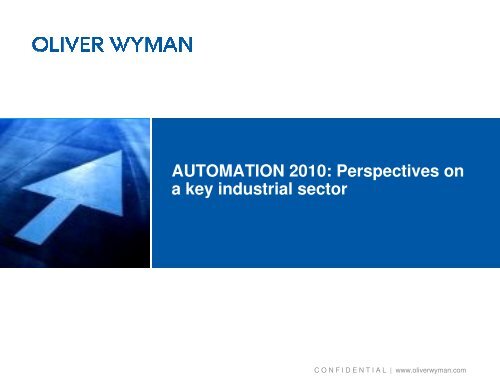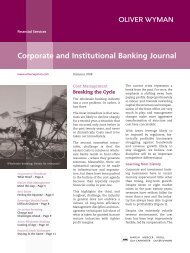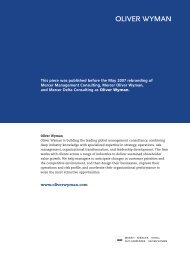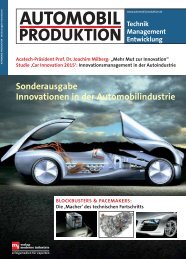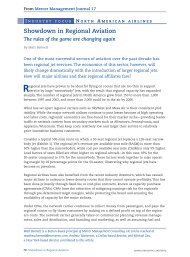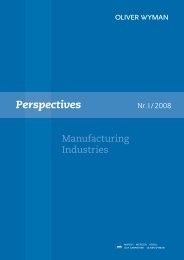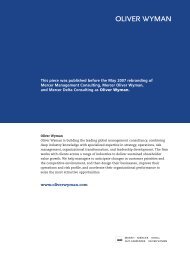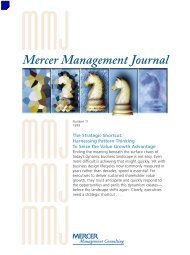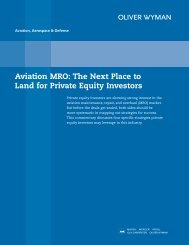Download the Report - Oliver Wyman
Download the Report - Oliver Wyman
Download the Report - Oliver Wyman
You also want an ePaper? Increase the reach of your titles
YUMPU automatically turns print PDFs into web optimized ePapers that Google loves.
AUTOMATION 2010: Perspectives on<br />
a key industrial sector<br />
C O N F I D E N T I A L | www.oliverwyman.com
Future Business design for automation companies were <strong>the</strong> core of <strong>the</strong> study<br />
Scope of <strong>the</strong> Study<br />
Remarks<br />
Services<br />
Products<br />
MES-Level<br />
Application software<br />
Controls<br />
(PLC, IPC, embedded)<br />
Hardware<br />
Software<br />
Field Level<br />
(Sensors, actuators, o<strong>the</strong>r)<br />
Industrial Communication<br />
HMI (Hard- / Software)<br />
The focus of <strong>the</strong> study is placed on <strong>the</strong> industrial<br />
automation sector (e.g. building automation and<br />
o<strong>the</strong>r adjacent automation sectors is only to<br />
covered to some extent)<br />
– Discrete Automation<br />
– Process Automation<br />
Interviews conducted reflect <strong>the</strong> interaction<br />
(channel structure) among players in <strong>the</strong><br />
automation field, e.g.:<br />
– Final customers: End users, OEM, …<br />
– Channel intermediaries (e.g. System<br />
Integration, EPC, O<strong>the</strong>r)<br />
Customer priorities are considered as main<br />
drivers of strategic challenges / opportunities for<br />
automation companies<br />
(<strong>Oliver</strong> <strong>Wyman</strong> outside-in-approach)<br />
Hardware<br />
Software<br />
© <strong>Oliver</strong> <strong>Wyman</strong> www.oliverwyman.com<br />
FSMUC1-CJU99906-Automatisierungsstudie (Kurzversion).ppt<br />
1
The objective of <strong>the</strong> study was to identify strategic challenges and winning<br />
business designs for automation companies<br />
Strategic challenges for automation players<br />
Key questions of <strong>the</strong> study<br />
Customer<br />
Requirements<br />
Structural changes<br />
(consolidation,<br />
globalization)<br />
In- / Outsourcing<br />
...<br />
Technology<br />
Trends<br />
Communication<br />
Standards<br />
Convergence<br />
Software<br />
Safety<br />
…<br />
Structural<br />
Shifts<br />
Consolidation<br />
New growth regions<br />
Redistribution of<br />
added value<br />
What are future profit zones /<br />
growth areas in <strong>the</strong> automation<br />
industry?<br />
Which business designs are<br />
suited to capture <strong>the</strong>se growth<br />
areas?<br />
What does that mean for <strong>the</strong><br />
respective players in <strong>the</strong><br />
automation sector?<br />
Value<br />
Business Design Innovation<br />
What strategic and operational<br />
changes have to be initiated?<br />
Current<br />
business<br />
design<br />
Future<br />
business<br />
design<br />
t<br />
© <strong>Oliver</strong> <strong>Wyman</strong> www.oliverwyman.com<br />
FSMUC1-CJU99906-Automatisierungsstudie (Kurzversion).ppt<br />
2
The automation market had a volume of appr. € 128,2 bn in 2005. Process<br />
industries represent over 70% of <strong>the</strong> total market<br />
Manufacturing Execution<br />
System (MES) 100%<br />
(1.1%)<br />
External<br />
services (22.8%)<br />
Internal<br />
services (28.4%)<br />
Standard software (3.0%)<br />
Communication buses (3.8%)<br />
Controls (9.7%)<br />
Human Machine Interface<br />
(HMI) (7.1%)<br />
Actuators (10.9%)<br />
Scales (1.1%)<br />
Process analysis machinery<br />
(2.2%)<br />
Sensors / instruments<br />
(9.9%)<br />
80%<br />
60%<br />
40%<br />
20%<br />
20.,1 12.6 6.5 11.1 8.7 6.7 4.3 8.5 3.2 4.7 4,8 15,3 6,8 8,2 2,4 1,3<br />
Process Industry<br />
€ 91.3 bn<br />
Discrete Manufacturing<br />
€ 36.9 bn<br />
Source: ARC, INTECHNO, <strong>Oliver</strong> <strong>Wyman</strong> Analysis<br />
Development of <strong>the</strong> automation market (2005; in bn €)<br />
Total volume: 128.2 bn Euro (externally accessible: 91 bn €)<br />
0% 20% 40% 60% 80% 100%<br />
Chemicals Power Metals Petrochemicals<br />
NUG<br />
Pharma Automobile Engineering<br />
Packaging Textile<br />
plants<br />
Environment<br />
Gas<br />
Oil &<br />
Paper<br />
Mining<br />
<strong>Oliver</strong> <strong>Wyman</strong> Automation Study 2010<br />
Rocks<br />
& soils<br />
Plastics<br />
Electronics<br />
Service =<br />
work<br />
performed<br />
internally and<br />
externally<br />
(installation,<br />
operation)<br />
Share of total<br />
market<br />
51%<br />
Business with<br />
parts /<br />
products<br />
(hardware,<br />
software)<br />
Share of total<br />
market<br />
49%<br />
Wood<br />
© <strong>Oliver</strong> <strong>Wyman</strong> www.oliverwyman.com<br />
FSMUC1-CJU99906-Automatisierungsstudie (Kurzversion).ppt<br />
3
Growth driven primarily by capital investments in <strong>the</strong> respective end user<br />
industries. Above average growth in process industries to be anticipated<br />
Market Development Industrial Automation<br />
By End-User industry, in bn €, 2005-2010<br />
Comments<br />
128.2<br />
150.6<br />
O<strong>the</strong>rs<br />
Electronics /<br />
Semicondutor<br />
General<br />
Machinery<br />
Automotive<br />
Environment<br />
Energy<br />
Food&Beverage<br />
CAGR 3.3%<br />
2.2%<br />
3.2%<br />
2.3%<br />
2.4%<br />
3.6%<br />
3.1%<br />
3.7%<br />
Process industry with above growth rates (%),<br />
due to:<br />
– Growth of <strong>the</strong> underlying end user segments<br />
– Regional growth impulses (green field or<br />
replacement investments)<br />
– Productivity gains through automation<br />
(e.g. pharma)<br />
Factory Automation in general with lower growth<br />
rates, due to:<br />
– Already higher automation level<br />
– Lower growth rates auf end user segments<br />
Petrochem<br />
Pharma<br />
Chemicals<br />
Metals<br />
Oil& Gas<br />
4.0%<br />
3.9%<br />
3.7%<br />
4.2%<br />
4.6%<br />
Differences across product types (sensor, drives<br />
versus controls/PLC) can be observed driven by<br />
e.g.:<br />
– Substitution / Migration<br />
– Technological development (convergence)<br />
– New Standards<br />
– …<br />
2005 2010<br />
Source: Market Studies, Analyst <strong>Report</strong>s, ARC, INTECHNO, <strong>Oliver</strong> <strong>Wyman</strong> Analysis<br />
© <strong>Oliver</strong> <strong>Wyman</strong> www.oliverwyman.com<br />
FSMUC1-CJU99906-Automatisierungsstudie (Kurzversion).ppt<br />
4
Growth impulses from regional shifts (Asia) to be expected: Biggest absolute<br />
growth in established markets (NAFTA, Western Europe)<br />
Volume in bn €<br />
56.3<br />
49.3<br />
CAGR: 2.7%<br />
2005 2010<br />
NAFTA<br />
Growth in key industries,<br />
moderate growth in o<strong>the</strong>r<br />
segments<br />
Impulses primarily by<br />
growth industry sectors<br />
as pharma / NUG<br />
Current positive impulse<br />
from positive CapEx<br />
investment versus<br />
structural development<br />
39.7<br />
34.9<br />
CAGR: 2.6%<br />
2005 2010<br />
West<br />
CAGR: 4.5%<br />
4.4 5.5<br />
2005 2010<br />
East<br />
Europe<br />
CAGR: 8.0%<br />
CAGR: 10.0%<br />
9.7<br />
6.1<br />
2005 2010<br />
China 1<br />
CAGR: 1.9%<br />
15.1 16.6<br />
Despite shift to China<br />
sufficient value generation<br />
remains in NAFTA<br />
Replacement investments<br />
primarily in order to increase<br />
productivity level<br />
In order to develop <strong>the</strong> market<br />
sustainably, significantly<br />
simpler automation solutions<br />
are necessary<br />
CAGR: 4.2%<br />
4.6<br />
5.7<br />
2005 2010<br />
South America<br />
Summary:<br />
Regional market<br />
development<br />
Established markets<br />
Future markets 28.9 38 5.6% 9.1<br />
1 Growth currently even higher<br />
Source: Intechno, ARC, <strong>Oliver</strong> <strong>Wyman</strong> Analysis<br />
2005<br />
99.3<br />
2010<br />
112.6<br />
Growth<br />
CAGR<br />
2.5%<br />
Abs.<br />
13.3<br />
2.0 2.9<br />
2005 2010<br />
India<br />
CAGR: 3.7%<br />
14.1<br />
11.8<br />
2005 2010<br />
ROW<br />
2005 2010<br />
Japan<br />
Strongly investments across<br />
many segments although<br />
different solutions:<br />
–International customers<br />
(MNC) maintain accepted<br />
automation solutions and<br />
focus on quality<br />
–Local Players for various<br />
reasons with simpler<br />
solutions<br />
International automation<br />
manufacturers dominate, but<br />
Chinese manufacturers become<br />
more important in <strong>the</strong> medium-<br />
& long-term<br />
© <strong>Oliver</strong> <strong>Wyman</strong> www.oliverwyman.com<br />
FSMUC1-CJU99906-Automatisierungsstudie (Kurzversion).ppt<br />
5
The automation is sector is facing several ra<strong>the</strong>r fundamental developments /<br />
trends with regard to products and technology<br />
Excerpt<br />
Underlying Trends in <strong>the</strong> Automation Sector (illustrative)<br />
A B C<br />
Low Cost Products<br />
Product to System<br />
New System<br />
Architectures<br />
ERP<br />
MES<br />
Past<br />
Future<br />
Products<br />
(e.g.<br />
drives) Systems /<br />
Solutions<br />
Control systems<br />
Field devices<br />
Equipment<br />
Emergence of low-cost-products<br />
Designed for simpler applications<br />
/ new customer segments<br />
Tailored to price sensitive<br />
customers<br />
Additional impulse through low<br />
cost competition from China<br />
(component level)<br />
Source: <strong>Oliver</strong> <strong>Wyman</strong> expert- and client interviews<br />
Customers no longer only refer to<br />
simple components, but want to<br />
buy systems<br />
– Defined, preconfigured<br />
interfaces<br />
– Test, operational guarantees<br />
System kits<br />
Selected segments such as:<br />
– Machine Tool<br />
– Packaging<br />
– Printing<br />
Future increases in productivity to<br />
be realized primarily on MES- and<br />
field-level<br />
Intelligent field devices (engines,<br />
sensors, etc.) / mechatronics<br />
Communication standards (e.g.<br />
industrial e<strong>the</strong>rnet) and break with<br />
proprietary systems facilitate shift<br />
Gradual dilution of profitable<br />
system components (risk for full<br />
liner)<br />
© <strong>Oliver</strong> <strong>Wyman</strong> www.oliverwyman.com<br />
FSMUC1-CJU99906-Automatisierungsstudie (Kurzversion).ppt<br />
6
Low cost trend will receive an extra impulse from <strong>the</strong> current emergence from<br />
Chinese competitors. Long-term upgrade of technology to be expected<br />
Excerpt<br />
Emerging Chinese Competitors (illustrative)<br />
PLC / Motion Control<br />
Drives<br />
(Frequency Converter)<br />
Sensors<br />
(primarily process industry)<br />
Shanghai Capital<br />
Bejing KND<br />
Bejing Aerospace<br />
Huazong<br />
Nanjing Washing KND<br />
GSK<br />
Dalian Dasen<br />
Chengdem Great Industrial<br />
Teco (Taiwan)<br />
Delta (Taiwan)<br />
Huifeng<br />
Continental Hope<br />
Ambition<br />
…<br />
Chinese Mid-Level Players<br />
(in total more than 170 players)<br />
Tian Cheng<br />
Suzhou Shihlin<br />
KeLi<br />
First MENS<br />
Zhonghang<br />
Shanghai Dongke<br />
CTS<br />
SAIS<br />
Goodsky<br />
Primarily on <strong>the</strong> component level (still with low technological competence, but improving)<br />
Heavy M&A activity in China as Western Players see China as an opportunity to jumpstart growth<br />
Source: <strong>Oliver</strong> <strong>Wyman</strong> research<br />
© <strong>Oliver</strong> <strong>Wyman</strong> www.oliverwyman.com<br />
FSMUC1-CJU99906-Automatisierungsstudie (Kurzversion).ppt<br />
7
Need for action of automation companies on different levels<br />
Level<br />
Elements<br />
1. Business design<br />
Customer<br />
selection<br />
Value<br />
Proposition<br />
Profit model /<br />
Strategic<br />
control<br />
Scope<br />
2. Specific optimization levers<br />
Sales<br />
effectiveness /<br />
Channels<br />
Procurement /<br />
Sourcing<br />
Product<br />
portfolio /<br />
Innovation<br />
3. Infrastructure and systems<br />
Organization<br />
Processes<br />
HR systems<br />
Tools<br />
Source: <strong>Oliver</strong> <strong>Wyman</strong> interviews (automation providers, customers)<br />
© <strong>Oliver</strong> <strong>Wyman</strong> www.oliverwyman.com<br />
FSMUC1-CJU99906-Automatisierungsstudie (Kurzversion).ppt<br />
8
<strong>Oliver</strong> <strong>Wyman</strong> is perfectly positioned to support automation companies to master<br />
<strong>the</strong> strategic challenges<br />
1<br />
Industry Expertise<br />
Thorough understanding of <strong>the</strong> automation industry as well as of essential<br />
purchasing industries<br />
Manifold project experience and references<br />
Studies and IC development<br />
2<br />
Innovative Strategy<br />
Approach<br />
Tried and tested approach for strategy development (“value driven business<br />
design”)<br />
Differentiated methodology and procedure<br />
Hypo<strong>the</strong>sis driven approach, quantitative orientation<br />
3<br />
Comprehensive Tool Kit<br />
Comprehensive tool kit / methodology for challenges of <strong>the</strong> automation industry<br />
(employed successfully in many projects)<br />
Comprehensive benchmarking database (best practice data)<br />
4<br />
Global Presence<br />
Worldwide > 2,500 employees in in 40 countries (global presence)<br />
International network of experts<br />
Access to local information / studies<br />
© <strong>Oliver</strong> <strong>Wyman</strong> www.oliverwyman.com<br />
FSMUC1-CJU99906-Automatisierungsstudie (Kurzversion).ppt<br />
9
1. <strong>Oliver</strong> <strong>Wyman</strong> has gained substantial and manifold project experience with<br />
leading automation companies<br />
<strong>Oliver</strong> <strong>Wyman</strong> Automation Experience<br />
(examples)<br />
Project content (examples)<br />
Portfolio strategy for a worldwide leading automation<br />
provider<br />
Growth strategy for a internationally leading provider in<br />
<strong>the</strong> area discrete control systems (PLC)<br />
Growth strategy for a internationally leading provider in<br />
<strong>the</strong> area process automation<br />
Growth strategy for a full liner with respect to <strong>the</strong><br />
introduction of a new product / technology<br />
Project in <strong>the</strong> area supply chain management for a<br />
leading provider in <strong>the</strong> area industry automation<br />
Divestment of a material handling provider<br />
Market entry strategies China for component players and<br />
system suppliers<br />
Growth strategy for a medium sized player specialized on<br />
sensors, vision, RFID<br />
Screening project for a full liner in <strong>the</strong> area of vision,<br />
RFID<br />
© <strong>Oliver</strong> <strong>Wyman</strong> www.oliverwyman.com<br />
FSMUC1-CJU99906-Automatisierungsstudie (Kurzversion).ppt<br />
10
1. <strong>Oliver</strong> <strong>Wyman</strong> has profound knowledge of <strong>the</strong> industrial sector<br />
Selection of <strong>Oliver</strong> <strong>Wyman</strong>’s client list<br />
Tools /<br />
Components<br />
Machine Tools<br />
Production<br />
Systems<br />
Engineering<br />
Construction<br />
Equipment<br />
Packaging<br />
High Tech<br />
Materials<br />
Industrial<br />
Services<br />
Trucks &<br />
Components<br />
Building<br />
Components<br />
Consumer<br />
Products<br />
Transportation<br />
Equipment<br />
© <strong>Oliver</strong> <strong>Wyman</strong> www.oliverwyman.com<br />
FSMUC1-CJU99906-Automatisierungsstudie (Kurzversion).ppt<br />
11
2. <strong>Oliver</strong> <strong>Wyman</strong>’s research has led <strong>the</strong> thinking on how firms can achieve<br />
sustained value growth<br />
2003<br />
2007<br />
2000<br />
2002<br />
1999<br />
1997<br />
1996<br />
1995<br />
Re-engineering<br />
is dead. Focus<br />
on <strong>the</strong> customer<br />
Value flows to<br />
<strong>the</strong> business<br />
design best<br />
matched to<br />
customer<br />
priorities<br />
Reinvention and<br />
profit-centric<br />
thinking are <strong>the</strong><br />
keys to<br />
sustained value<br />
growth<br />
Pattern thinking<br />
helps executives<br />
see tomorrow’s<br />
profit zones<br />
before <strong>the</strong><br />
competition<br />
Explore <strong>the</strong> many<br />
ways that profit<br />
Winning business<br />
happens<br />
designs in <strong>the</strong><br />
next economy will<br />
be dynamically<br />
assembled around<br />
customer priorities<br />
To renew growth,<br />
shift from product<br />
innovation to<br />
demand<br />
innovation<br />
Strategies for<br />
Turning Big<br />
Threats into<br />
Growth<br />
Breakthroughs<br />
© <strong>Oliver</strong> <strong>Wyman</strong> www.oliverwyman.com<br />
FSMUC1-CJU99906-Automatisierungsstudie (Kurzversion).ppt<br />
12
3. We ensure tangible results and efficient change by a balancing rigor analytics<br />
and sensitive process coaching<br />
<strong>Oliver</strong> <strong>Wyman</strong> as <strong>the</strong> “analytic” consultant<br />
Content<br />
Thought leadership<br />
Rigorous and fact based<br />
Best practice / benchmarks<br />
Deep understanding of clients’ business<br />
Modeling of options and decision support<br />
Pragmatic and results driven<br />
Value based approach<br />
<strong>Oliver</strong> <strong>Wyman</strong> as <strong>the</strong> “coaching” partner<br />
Process<br />
Structuring, work planning<br />
Applied from best practices<br />
(process / Do's and Don’ts)<br />
Process management, team building and<br />
sub-team management<br />
Support in communication and change<br />
process<br />
Challenging <strong>the</strong> option, “watch-dog“ role<br />
Attention to Labor Relations issues<br />
Know-how transfer<br />
Source: <strong>Oliver</strong> <strong>Wyman</strong> Management Consulting<br />
© <strong>Oliver</strong> <strong>Wyman</strong> www.oliverwyman.com<br />
FSMUC1-CJU99906-Automatisierungsstudie (Kurzversion).ppt<br />
13
4. <strong>Oliver</strong> <strong>Wyman</strong> is a global consulting company and a part of Marsh & McLennan<br />
Companies<br />
Revenues 2006: 12 bn. US-$<br />
Employees: 55.000<br />
Offices in more than 100<br />
countries<br />
Marsh<br />
Guy Carpenter<br />
Kroll<br />
Mercer<br />
<strong>Oliver</strong> <strong>Wyman</strong><br />
<br />
<br />
<br />
<br />
Risk and insurance services<br />
Risk management,<br />
consulting and transfer<br />
Design and<br />
administration of<br />
insurance programs<br />
Managing general<br />
agency<br />
Claims management<br />
<br />
<br />
<br />
Reinsurance placement<br />
risk quantification and<br />
assessment<br />
Run-off administration<br />
Risk consulting and<br />
technology<br />
Legal technologies<br />
Background screening<br />
Credit screening<br />
Corporate<br />
investigations<br />
Competitive<br />
intelligence<br />
Forensic accounting<br />
restructuring advice<br />
Security consulting<br />
and training<br />
Human Ressource<br />
Consulting<br />
<br />
<br />
<br />
<br />
<br />
<br />
HR Strategy<br />
HR Systems<br />
Compensation<br />
Benefits<br />
Communication<br />
…<br />
Top-Management<br />
Consulting<br />
<br />
<br />
<br />
<br />
<br />
<br />
Strategy<br />
Organization<br />
Operations<br />
Efficiency, cost<br />
reduction<br />
Risk Management<br />
Leadership<br />
Transformation<br />
<br />
Revenues 2006: ~ 5,5bn US-$<br />
Employees: 32.400<br />
<br />
400 offices in 100 countries<br />
Revenues 2006:<br />
980m US-$<br />
Employees : 3.600<br />
<br />
65 offices in<br />
23 countries<br />
Revenues :<br />
~ 3,0bn US-$<br />
Employees : 13.000<br />
<br />
150 offices<br />
Revenues :<br />
~ 1,3bn US-$<br />
Employees : 2.500<br />
<br />
40 offices<br />
© <strong>Oliver</strong> <strong>Wyman</strong> www.oliverwyman.com<br />
FSMUC1-CJU99906-Automatisierungsstudie (Kurzversion).ppt<br />
14
4. With a staff of more than 2,500 in over 40 offices in <strong>the</strong> Americas, Europe, Asia,<br />
and <strong>the</strong> Middle East, clients around <strong>the</strong> world can leverage our capabilities<br />
We have over 35 years of experience serving Global 1000 clients.<br />
© <strong>Oliver</strong> <strong>Wyman</strong> www.oliverwyman.com<br />
FSMUC1-CJU99906-Automatisierungsstudie (Kurzversion).ppt<br />
15
© <strong>Oliver</strong> <strong>Wyman</strong> www.oliverwyman.com<br />
FSMUC1-CJU99906-Automatisierungsstudie (Kurzversion).ppt<br />
16


